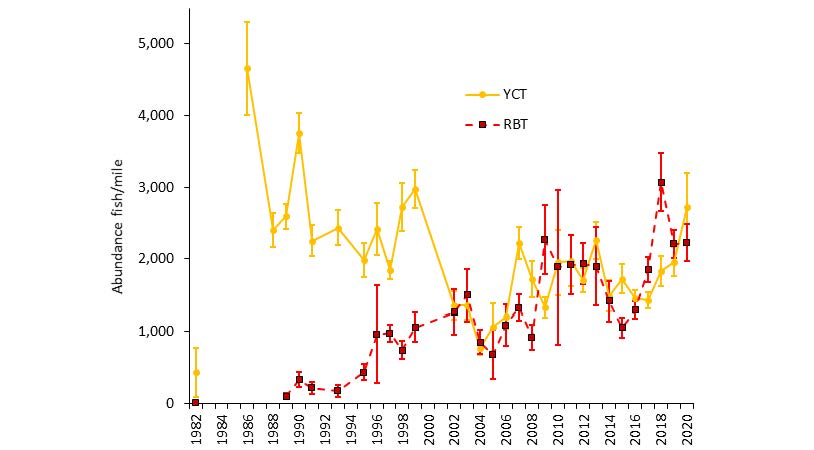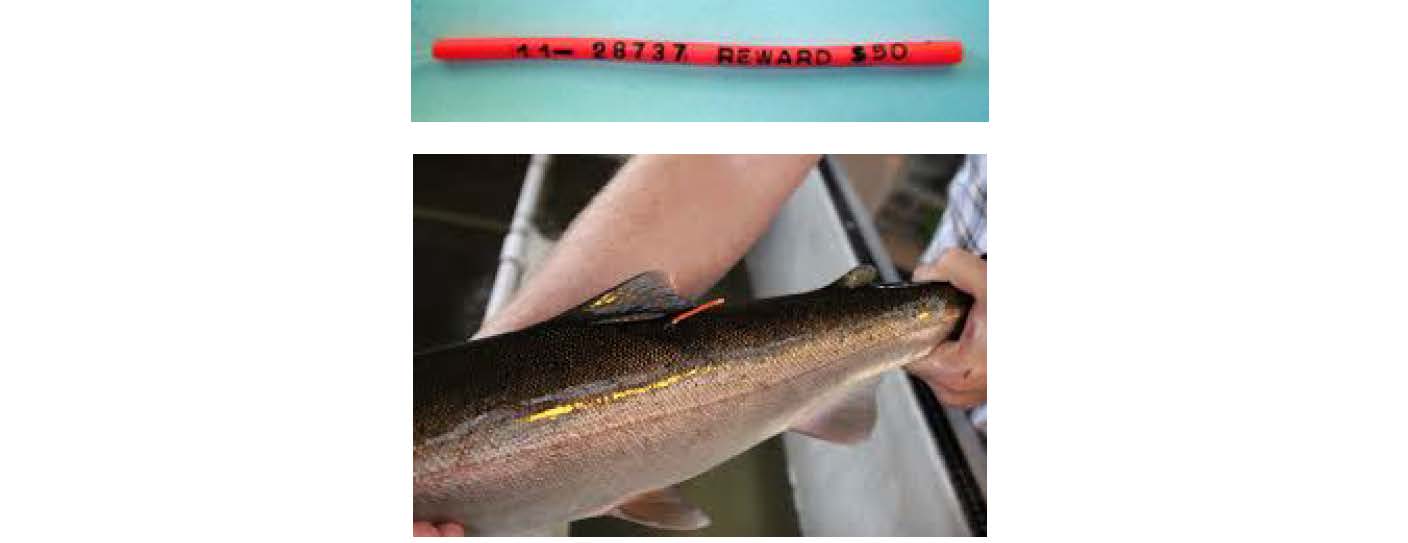The South Fork Snake River (SFSR) supports the strongest remaining fluvial population of native Yellowstone Cutthroat Trout Ocorhynchus clarkii bouvieri (YCT) within their historical range in Idaho. The SFSR is one of only a handful of large rivers in the species’ range that supports a robust population of YCT. The primary goal for the SFSR, as directed by the public and the Idaho Department of Fish and Game (IDFG) Commission, is the preservation of the genetic integrity and population viability of YCT. In the late 1990s and early 2000s, Rainbow Trout O. mykiss (RBT) abundance increased in the main stem SFSR. Rainbow Trout and RBT x Cutthroat Trout hybrids (collectively RBT hereafter) are the biggest threat to the continued persistence of YCT in the SFSR because of risks through competition and hybridization. Abundance of RBT has increased significantly in recent years to the extent that RBT were twice as abundant as YCT in 2018 increasing the potential for hybridization and competition (Figure 1).
Since 2004, the IDFG and collaborators have implemented several YCT conservation management strategies in the SFSR drainage to support the viability and genetic integrity of these populations. In 2017, a statewide survey of anglers identified that management for native YCT was a top priority. This priority is a driver for the current Fisheries Management Plan which outlines the objective of limiting RBT prevalence to less than 10% of the trout species composition of the catch at the Conant monitoring reach measured during annual fall abundance surveys. The 10% threshold would return species compositions similar to those documented during the early to mid-1980s.

Beginning in 2018, IDFG investigated the feasibility of using boat electrofishing equipment to suppress RBT abundance in the main stem of the SFSR, by electrofishing several isolated locations multiple times and observed the changes in the number of RBT caught each outing. Rainbow trout re-populated spawning areas, suggesting that a substantial number of RBT could be removed. In 2019, IDFG further investigated available equipment and staffing to estimate the number of RBT that a moderate level of suppression could achieve and the logistics it required. This effort resulted in the removal of approximately 6,000 RBT from the SFSR. This result was encouraging and with additional efforts might provide a significant benefit to the YCT population.
A thesis completed in 2014 by Evalinda DeVita identified that RBT numbers should be decreased annually by approximately 20% to effectively manage threats to YCT. Due to inherent variability in all biological systems, and the record high abundances, we believe a suppression goal of 30% would be appropriate in order to decrease R”BT abundance and halt the increasing trend of RBT in to subsequent years. In the fall of 2020, IDFG estimated 2,230 RBT/mi. (± 259) in the Conant monitoring reach (Figure 1). The Conant monitoring reach is a fraction of the upper river where RBT are most abundant, so to estimate the total number of RBT to remove through suppression, we multiplied 2,230 by the distance between Palisades Dam to Dry Canyon (19 mi.), to estimate a minimum of 42,370 RBT in the SFSR. Thirty percent of the total number of RBT is 12,711. Therefore, our goal is to remove a minimum of 12,000 RBT from the SFSR in 2021.
To achieve our goals in 2021, IDFG plans to suppress RBT in the SFSR using boat electrofishing four days per week (Mon – Thur), from Monday, April 19 – Thursday May 27 (Table 1). Work should begin around 8:00 a.m. and will cease around 3:00 p.m. Additionally, RBT may be removed during fall surveys or at other times opportunistically.

Removing RBT to the extent of achieving our goal, would return the SFSR near the 10-yr. average of total trout/mi. Additionally, with currently high RBT, the effort required in 2021 is likely to be significantly higher than future efforts, where suppression in subsequent years will require less effort if we are successful in 2021. The effort required in every subsequent year will depend on our success the year prior and the level of natural production of RBT occurring.
All RBT removed from the SFSR will be translocated to other waters. Some Rainbow Trout removed from the river will be stocked into public fishing ponds, including Louis (Swan Valley), Trail Creek, and Jim Moore ponds early during suppression efforts. However, as pond temperatures warm, the majority of the RBT removed from the SFSR are going to be stocked in the lower Henry’s Fork where RBT numbers are low. A proportion of the RBT released into the Henry’s Fork will be marked with orange T-bar anchor tags for IDFG’s “Tag, You’re It” program (Figure 2). These tags will help us determine how translocated fish benefit the receiving fisheries, and determine how far these fish move after being introduced into new waters. If you encounter one of these tags, please report it following the instructions on the tag, or at https://idfg.idaho.gov/fish/tag/add?no_cache=1617646869.
The South Fork Snake River is an incredible fishery in the Upper Snake Region, supporting a diversity of fish species for wild trout. We are optimistic this year’s suppression efforts will provide progress towards the goals and objectives identified by the anglers of Idaho to conserve native YCT. Specifically, we hope to make significant progress toward the goals in IDFG’s fisheries management plan for the SFSR of protecting Cutthroat Trout genetic integrity and decreasing RBT abundance.

